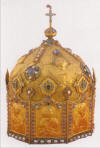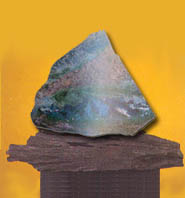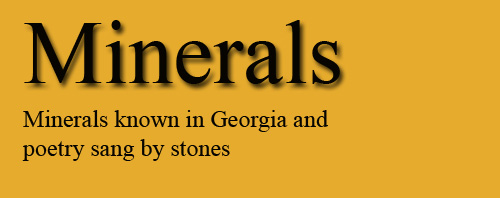|
  
The turquoise


The turquoise is one of the most beautiful jeweler. It is famous
for humanity from the ancient time. In Persian, the turquoise
means the happy gem. In Arabian ōturquoiseö
(ō
Phirujaziö) means the gem, Which helps us to win. the turquoise
is also called Klait. (In Greek it means ōbeautifulö).
The chemical structure of the turquoise is: CuAl6
[PO4][OH]24H20, CuO ¢ 9,78%, Al2O3
¢ 37.06%, P2O5 ¢ 34,90%, H2O ¢ 17,72%. As an
admixture - Fe2O3 - 21%. Besided the
iron , in turquise , we can meet Ca ,
Zn,Mg,Cr,Ti,V,Sr,Ba,Mn,Na,Ag,B,Co,Pb,Si. as the admixtures. The
organic thing turquoise was seemed as an amorphous mineral
before. Nowadays, itÆs ascertained that it gets crystal. The
firmness is 5-6: the compactness ¢ 2600 ¢ 2800 Kg/m3
, the lightning vague, the colour of wax. The colour ¢ blue ,
sky-blue, light blue in green. ItÆs good topolish it for the
reinforcement of colour.
The turquise may be arised by the analising the acid
of phosphorus and the copper is arisen from its ore . The
superficial water is very important too: the formation of
turquoise has a link with the precipitate and metamorphycal
rocks. The turquise arises in precipitate rocks.
The layers of turquoise are in: Egypt, Ccina ¢Tibet ,
Kasakhstan, Turksmen, Uzbek, Afghanistan, USA, Austrelia,
Armenia, Israel. The famous layer of the world is in Iran-
khorasan.
In Georgia Turquoise3 is famous at the layer of ore
copper ¢ in Bolnisi. By the proffesor G.Gvakharia, ore turquoise
is the product of hydrotermic somatic process.
Archeology gives us an important material of the using
of turquise as a beed, from the late Bronze age and the early
Iron age (BC XIII ¢ VII). The turquoise is often found in the
sepulchree of the antique age This gem adorns ZevakhiÆs girdle:
there is an ōalmond-shape nestö on the round buckle, in which
there is a big (3cm length) gem of turquoise . The tueguoise
also adorn the buckles of Asparugi. A gilden diadem is adorned
with the gems of turquoise , the golden necklace (II ¢ III) is
adorned with the tuoguoise and Almandi. The gems of turquoise
are often found in the sepuichre. (the ground of authors
ōMtskhetaö).
In middle ages Georgia , the turquoise and the other
gems were spread . The turquoise was often used for adorning the
church stock ¢ icons, crosses and so on.
The Mitropoliss cross and the golden piece of Martvili
is adorned by the turquoise. This gem adorns the virginÆs icon
(X- XI)- in Khobi the golden folding icon of our Saviour and the
martyrÆs leaderÆs cross. (XII)
ōThe golden ring with the 32 gems of turquoiseö is
mentioned in 1460 №124 deed of Mtskheta.
King RostomÆs wife ¢ the queen Mariam (1634) and Erekle IÆs
wifeÆs dowry books gives us a very interestind meterial about
using the turquoise for the adornment and there is shown , that
the ear-rings, bracelets and necklaces were adorned by the sal
ammoniac turquoise . There is also mentioned the turquoise in
dowry book of Elene and Anna Eristavi of Ksani. The turquoise is
oftrn used in the manuscript or printed book ¢ covery as the
adornment. (The first printed book of gospel). |




